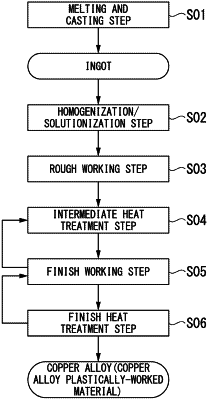| CPC C22C 9/00 (2013.01) [C22C 1/0425 (2013.01); C22C 2200/00 (2013.01); H01B 1/026 (2013.01)] | 11 Claims |

|
1. A copper alloy having a composition including:
70 mass ppm or more and 400 mass ppm or less of Mg;
5 mass ppm or more and 20 mass ppm or less of Ag;
less than 3.0 mass ppm of P; and
a Cu balance containing inevitable impurities, wherein
an electrical conductivity of the copper alloy is 90% IACS or more, and
an average value of KAM (Kernel average misorientation) values is 3.0 or less,
the KAM values being obtained by:
analyzing orientation differences of each of crystal grains by using an EBSD method in a measurement area of 10000 μm2 or more in a step of a measurement interval of 0.25 μm, excluding measurement points having a CI value of 0.1 or less;
calculating an average crystal grain size A by using area fraction, regions between neighboring measurement points where the orientation differences therebetween is 15° or more being defined as crystal grain boundaries;
measuring the orientation differences in a step of a measurement interval that is 1/10 or less of the average crystal grain size A;
analyzing the orientation differences of each of the crystal grains in a plurality of view fields including 1000 or more of the crystal grains in total, each of the view fields having 10000 um2 or more of a measurement area, excluding measurement points where a CI value analyzed with data analysis software OIM is 0.1 or less; and
obtaining the KAM values as values when grain boundaries are defined as boundaries having 5° or more of orientation differences between neighboring pixels.
|